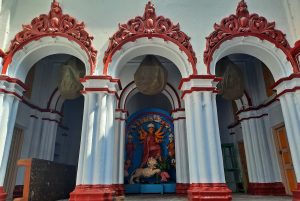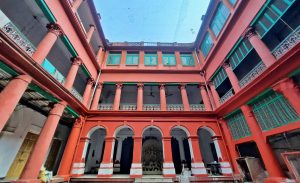 The autumn air is replete with the festive fervour of Durga Puja, Bengal’s biggest festival. Kolkata alone holds around 3000 pujo annually. While the big and famous venues known as barowari or community pujas dominate the scene to pay obeisance to the Shakti Goddess, the old and historical venues too have continued to hold forth with their hundreds of years’s existence. IBNS-TWF lensman Avishek Mitra captures some pre-puja portraits of north Kolkata’s aristocratic family pujas
The autumn air is replete with the festive fervour of Durga Puja, Bengal’s biggest festival. Kolkata alone holds around 3000 pujo annually. While the big and famous venues known as barowari or community pujas dominate the scene to pay obeisance to the Shakti Goddess, the old and historical venues too have continued to hold forth with their hundreds of years’s existence. IBNS-TWF lensman Avishek Mitra captures some pre-puja portraits of north Kolkata’s aristocratic family pujasThese days there are even special tour packages for those interested to soak in the ambience of the bonedi barir pujo (loosely translated into pujas of the aristocratic households or families) across Kolkata, with most located in the old northern part of the city.
These family pujas are mostly held by progeny of erstwhile zamindar families who flourished in colonial times. In fact, once it was the prerogative of the rich and powerful to organise Durga puja in their elaborate dalans. It was much later that twelve (baro) friends initiated a community puja – hence barowari , with public donations, the community puja came into vogue.
The bonedi pujas hold forth with their age-old traditions while taking pride in their heritage. In Behala in south Kolkata, the family puja of the Sabarna Roy Chowdhurys is 370 years old. The family claims to be the original ‘father’ of the city before the East India Company reinvented it as Calcutta. Its Atchala Durga Puja, started in 1610, is said to be the oldest Durga puja in Kolkata.
North Kolkata, the hub of the city in colonial times, where the zamindars built their palatial houses, has a concentration of bonedi pujas.
Prominent among them is the Sovabazar Raj Bari Durga Puja which was started by Raja Naba Krishna Deb in 1757. It was also to commemorate the British victory at the Battle of Plassey and Robert Clive who had defeated Siraj-ud-daula, the nawab of Bengal, was an invitee. It was the first time when non-Hindus were allowed to attend a household Durga Puja.
In the vicinity is Bagbazar Haldar Bari Durga puja, celebrated since the 19th century, though the tradition is said to go back to another two centuries. The deity is a touchstone (paras-pathar) idol. There are two winged angels above the devi (goddess) on both sides and two tiny female figures at her feet. These two female figures might be that of Jaya and Bijaya, the companions of Parvati or Durga.
The Laha family’s Durga Puja at ‘Laha Bari’ on Bidhan Sarani is over two centuries old. The Durga Puja was started by Bhagabati Charan Laha. The Puja is now hosted alternatively at different locations by different branches of the family. Interestingly, here the goddess is seated on the lap of Lord Shiva with her eyes closed. This is known as ‘Hara-Gouri’.
The Chhatu Babu Latu Babu’s Durga Puja held in a red-coloured grand building on Beadon Street celebrates one of the oldest Durga pujas of Kolkata. It was first organised in 1770 by Ram Dulal Deb (Sarkar), a leading entrepreneur of the day.
Patuatola Bannerjee Family Durga Puja dates back to 1890 and was started by Beni Madhob Banerjee who was the first Indian attorney.
 Haatkhola Dutta Family Durga Puja has been going on since 1794. Here Durga’s attire is made of clay not of a cloth material.
Haatkhola Dutta Family Durga Puja has been going on since 1794. Here Durga’s attire is made of clay not of a cloth material.
The Chorbagan Chatterjee family traces its origin to Khulna, now in Bangladesh. Ancestor Dhanabijay Chatterjee settled down in Kolkata and his grandson, a prosperous businessman, started the puja in 1860 at his Muktaram Babu Street residence.
Rani Rashmoni, the founder of Dakshineswar Kali Temple, and chief patron of Ramkrishnadeb, had her house at Janbazar in the heart of Kolkata. The Rani Rashmoni’s family Durga Puja is one of the most celebrated family pujas in Kolkata.




 Haatkhola Dutta Family Durga Puja has been going on since 1794. Here Durga’s attire is made of clay not of a cloth material.
Haatkhola Dutta Family Durga Puja has been going on since 1794. Here Durga’s attire is made of clay not of a cloth material.